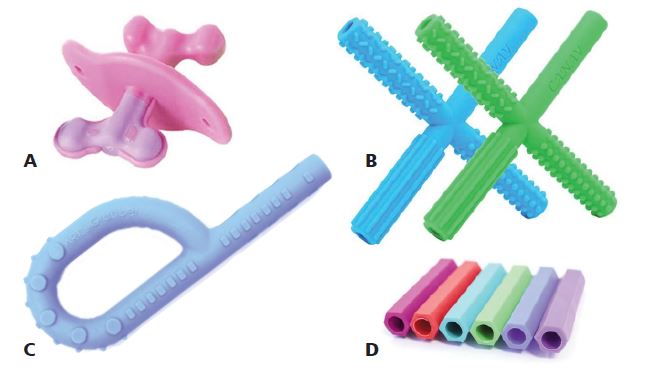teeth. Simply put, most children know what types of food she can eat and what types she cannot.
But for Children with Special Health Care Needs (CSHCN), learning to bite and chew food is challenging and, specifically, most difficult for those with sensory integration type disorders. Learning to bite and chew is dependent on the sensory properties of the food (rheology) and the feeling of that food in the mouth, both at the first bite, second bite and progressive chewing. Palate size and shape, tongue function, soft tissue concerns such as lip and tongue frenum attachments, mouth breathing, and yes, even teething, to the "art of chewing."
PROCESSED FOOD, CHEWING AND DRINKING FROM A CUP
There are health benefits of chewing. Chewing stimulates oral myofunctional development. Crooked teeth affect chewing and chewing affects crooked teeth. Chewing is integrated with breathing, sucking and affects the whole development of the craniofacial-respiratory system. So, what do we do when our child has cognitive and sensory delays that present as difficulties in chewing – and we revert to soft proceed foods as a "safety measure," and spouted sippy cups as a carpet-saving strategy? Both are compounding difficulties, and both are delaying their feeding and drinking skill maturation.
CHEWERS, TEETHERS AND ADJUNCTIVE CHEW APPLIANCES
Oral motor chew tools and specifically designed teethers are an excellent way to provide oral stimulation, exercise the mouth muscles, build oral tone, and practice biting/chewing skills.
So back to rheology. Specifically, resistance, sensory input, size shape texture, consistency placement and oro-motor skills for creation of a bolus to prepare for the swallow are critical parameters in food progression. Oh yes, again… let's not forget the role of the teeth (10 teeth chew better than six, and 20 teeth chew better than 12).
- Aceli' Trainer teether with a varied response to biting (patent pending). The teether can replicate and coordinate this natural progression. The teether can achieve the various textures, firmness, and compressibility of different foodstuffs. Through textures, design features and teether response, the teether can replicate and coordinate the child's natural feeding and speech progression. Training the child with the teether can accelerate transitions between feeding stages and help develop control required for speech.
- ARK Grabber for speech and oral motor development texture aversions drinking, feeding and chewing.
CHEW ON THIS : SPECIFICALLY DESIGNED TEETHERS

CHEWER BEWARE: Chewther aids can be both helpful and harmful; (A) Aceli' Teethers from Toothprints PC; (B) Canay Hollow chew tubes (C) ARK Grabber chew (D) ARK pencil tip chew; Chewable toothpicks or extra hard pencil toppers may cause oral trauma if a child falls, or the chew aid becomes driven to the back of the throat from an impact.
A WORD OF CAUTION
Chew aids, or perhaps better called "Chewther toys," should be selected specific for the age and development of the infant, toddler of child. Designs such as the ARK chewable toothpicks, or extra hard pencil toppers, as well as the Canay straight hollow tubes, may cause oral trauma (impalement injuries) if a child falls, or the chew aid becomes driven to the back of the throat from an impact. Devices that limit the depth of the chewther or teether when placed in the child's mouth (often called a safety shield), such as the Gifty Hollow teether tube, are best advised for children with unsteady gate, newly walking toddler, or those with poor hand -eye coordination. Also, there have been reports of pieces of these textured chewthers breaking off, and it has cause for concern of the parents. Any problems or injuries with "Chew aids" of any kind or brand, please let me know at tesini22@gmail.com and I am happy to follow up with the company for you.
As with all teethers, pacifiers, chew aids or toys, parents should supervise the use, regularly inspect and replace the product if the item shows signs of cracking, wear or tear.
FINAL WORD
Pediatric dentists and speech and language pathologists are good resources able to evaluate oral anatomy and oro-myofunction during speech, feeding and breathing. They will be able to offer a diagnosis and direct parents to treatment options. •
ABOUT THE AUTHOR:

David A. Tesini DMD, MS, FDS RCSEd, is a retired pediatric dentist with ongoing positions and an Associate Clinical Professor at Tufts University School of Dental Medicine, and President of Toothprints PC, a baby product design company. He was past president of the C D CHEWER BEWARE: Chewther aids can be both helpful and harmful; (A) Aceli' Teethers from Toothprints PC; (B) Canay Hollow chew tubes (C) ARK Grabber chew (D) ARK pencil tip chew; Chewable toothpicks or extra hard pencil toppers may cause oral trauma if a child falls, or the chew aid becomes driven to the back of the throat from an impact. Academy of Dentistry for Persons with Disabilities (ADPD) and parliamentarian/trustee of the American Academy of Pediatric Dentistry (AAPD). He was a co-founder of Project Stretch: Dentistry Reaching out to Children, a non-profit organization providing free care to impoverished children around the world. He and his wife Bernadette enjoy spending time at the family vineyard in Italy producing their award-winning Prosecco Venti22due.